Extreme neutrinos
Searching for the secrets of the universe in the depths of the earth.
by Katie Yurkewicz
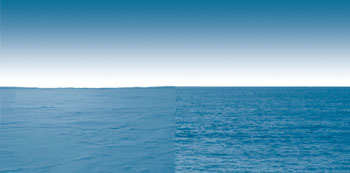 |
Kurt Woschnagg has been waiting nine days to catch a plane to the South Pole. He flew for 15 hours from San Francisco to New Zealand, waited several days to spend another eight hours in a cargo plane to McMurdo Station in Antarctica, only to wait again for the weather to clear. Finally, wearing layers of cold-weather gear topped off with a bright-red parka, he is stuffed into a C-130 cargo plane for the last leg of his trip. He emerges three hours later at the South Pole—an ice sheet at 2840 meters elevation, with a temperature of -30°C and air drier than the driest deserts.
Fifteen thousand kilometers away, Vincent Bertin is on a ship in the Mediterranean Sea. He will spend the next seven hours lying on his stomach, in a titanium sphere two meters in diameter, with two other men—the pilot and co-pilot of the submarine Nautile. Bertin squeezes into the small craft, recalling the instructions to turn off the oxygen immediately in case of fire. He hopes nothing goes wrong. A huge rope lifts the Nautile out of the ship and deposits it in the sea. An hour later, the three men reach the sea floor, 2500 meters below the surface.
Woschnagg and Bertin, both particle physicists, are going to extreme environments to study some of the most exotic phenomena in the universe.
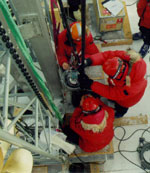 |
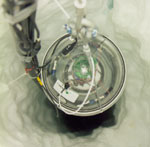 |
In search of colliding galaxies, exploding stars, gamma-ray bursts and dark matter, Woschnagg and Bertin are building the largest particle detectors in the world. These are a new type of telescope using high-energy neutrinos, instead of light, to view the sky. Neutrinos make ideal astronomical messengers. They have no electric charge, almost no mass, and are extremely difficult to catch—trillions of neutrinos stream through your body every second without a trace. Unlike light, they travel unhindered from the distant reaches of the universe, and from the very centers of violent astrophysical phenomena.
"Once you've flown down there, you never complain about commercial aviation again."
"Neutrinos reveal different information about the same objects," explains theoretical astrophysicist John Beacom from The Ohio State University. "It's the difference between a photograph of a person and an x-ray."
Neutrinos can "x-ray" gamma-ray bursts—extremely high-energy explosions whose origins are a mystery; they can penetrate the cosmos, displaying the farthest and oldest parts of the universe; and, they can offer clues to the sources of high-energy cosmic rays that constantly shower the earth with energies up to 100 million times that of the most powerful particle accelerators. Neutrinos produced in the centers of stars and galaxies could hold clues to the invisible dark matter comprising some 25 percent of the universe.
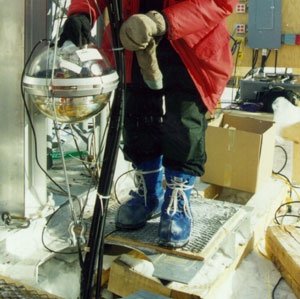 |
First, physicists must catch them. Because neutrinos interact with matter so rarely, giant detectors are needed to measure their energies and directions. Detectors big enough to see neutrinos from a distant galaxy would be prohibitively expensive to build. Physicists are calling on nature to measure what nature has made so elusive, using large quantities of water and ice to turn the earth itself into a great neutrino detector.
Deep freeze—in summer
Woschnagg, a physicist from the University of California, Berkeley, has ventured to the Antarctic seven times to build a neutrino telescope— the Antarctic Muon and Neutrino Detector Array (AMANDA), frozen 2000 meters deep in the South Pole ice.
With hundreds of detectors, called photomultiplier tubes (PMTs), frozen in the ice, AMANDA researchers measure the properties of neutrinos coming through the earth from the northern sky. A neutrino traveling through the earth from the north will occasionally crash into a proton or neutron, creating another subatomic particle called a muon. The muon enters the South Pole ice from below, traveling extremely fast—so fast that it gives off a shock wave of faint blue and ultraviolet light. The PMTs embedded in the ice can track the muon as it travels through the telescope, allowing researchers to reconstruct the original neutrino's energy and direction and determine its point of origin in the cosmos.
| Empire State Building Height: 443 meters 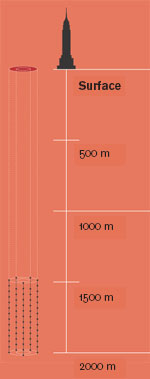 AMANDA Depth: 2000 meters Cables: 19 Detectors: 700 |
Tracking the muon can be difficult due to dust from the Sahara desert that drifted to the South Pole between 40,000 and 70,000 years ago. The Sahara dust embedded in the deep ice causes the blue and UV light to scatter, masking the muon's true speed and direction.
PMTs act like light bulbs in reverse—when a photon of light enters a PMT, an electrical signal is generated. The PMTs are enclosed in pressure-resistant glass spheres bigger than bowling balls. In AMANDA, 700 of these glass optical modules are arranged on 19 electrical cables, like beads on a string 2000 meters long. The optical modules are positioned between 1500 and 2000 meters deep in the ice. The electrical cables rise to the surface, where the PMT signals are digitized and sent to computers for analysis. The AMANDA array encloses a volume of ice 500 meters tall and 200 meters wide—bigger than the Empire State Building.
The Antarctic summer allows about 3 months of working time per year, and storms are common, especially early in the season. All the AMANDA components, along with equipment for assembly and installation; electronics and computers to make sense of the detector signals; and food, clothing, and fuel for researchers, must be flown to the South Pole in dozens of huge C-130 cargo planes, at the whim of weather and wind.
"Pilots don't have any ETAs. They're happy to get you down there in a day or two," says Steve Barwick, a professor at the University of California, Irvine, and co-spokesperson of the AMANDA experiment. "Once you've flown down there, you never complain about commercial aviation again."
After arriving and waiting a few days to adjust to the polar climate, Woschnagg, Barwick, and their fellow AMANDA researchers wait again. A dozen professional ice drillers create a two-kilometer deep, half-meter wide hole, using a hot-water drill that works at one centimeter per second. Running in shifts around the clock, the drilling takes 70 hours. The minute the drillers have finished, the researchers suit up in huge red parkas, giant boots, gloves, sunglasses and sunscreen, grab hand- and foot-warmers and tools, and head onto the ice. They work in shifts for the next 20 hours, sometimes without gloves, in temperatures of -20°C to -40°C to install one string of the AMANDA detector.
"If there's a little bit of wind, you get frostbitten," says Barwick. "The water in your skin freezes and causes your skin to puff up, and since your nose sticks out, you end up with a little white Bozo nose."
"It's all going to be there for 100,000 years until it's swept into the ocean."
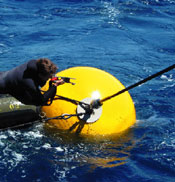 Photo: ANTARES |
The scientists lower the two-kilometer electrical cable into the hole, attaching one optical module every 17 meters. After the last optical module is attached, the rest of the string is lowered and held in place. The deployment must be completed within 30 hours, before re-freezing halts the work. The AMANDA array, and everything else ever buried at the South Pole—a cargo plane that broke down years ago, the old South Pole station—are entombed in the Antarctic ice.
"It's all going to be there for 100,000 years until it's swept into the ocean," says Woschnagg.
AMANDA's installation was completed in 2000, but its data has produced no extraordinary results yet.
"We're seeing about 800 high-energy neutrinos a year," says Barwick, "but all are consistent with neutrinos being produced in the earth's atmosphere."
| Deepest Military Submarine Depth: 900 meters  ANTARES Depth: 2500 meters Cables: 12 Detectors: 700 |
"Atmospheric" neutrinos, produced by interactions of cosmic ray par-ticles with the earth's atmosphere, might be useful for studying the properties of neutrinos. But if you're hunting sources of neutrinos in the universe, atmospheric neutrinos are nothing but noise.
The Baikal Neutrino Telescope, the first underwater neutrino detector array, has reported similar results. The telescope, located in Siberia's Lake Baikal at a depth of 1.1 kilometers, covers a 43-meter diameter, 72-meter high area of the lake. Baikal looks through the earth for neutrinos from the southern hemisphere. One-tenth the size of AMANDA, Baikal was completed in 1993 and has been collecting data for over 10 years. Baikal has seen hundreds of atmospheric neutrinos, but no exotic astrophysical sources or dark matter annihilations.
A pitch-black undersea beach
Bertin's voyage to the bottom of the sea took place in 1999. A physicist at the Centre de Physique des Particules de Marseille, he was scouting a location 2500 meters deep and 40 kilometers off the coast of Toulon, France, for an underwater neutrino telescope, the Astronomy with a Neutrino Telescope and Abyss Environmental Research. The 150-meter wide, 300-meter high ANTARES array needed a deep, flat and featureless section of sea floor.
"It was like a huge beach," Bertin recalls of his view from the small submarine. "At that depth there is no sunshine at all, so there are no plants or algae and very few fish. It was also amazing to see many bottles of beer, cans, plastic bags—there is nothing to hide them."
While beer cans and bottles are no obstacle to underwater telescopes, ANTARES faces other environmental and technological challenges. The telescope will have 900 optical modules strung along 12 electrical cables, all of which must be kept leak-free—even a tiny leak would destroy the PMT inside. A small mechanical weakness in the glass optical module could cause it to implode at the depth of ANTARES, where the pressure is 200 to 240 times that at the surface.
Salt water contains a radioactive isotope of potassium, whose decay produces a speeding electron. That electron can emit blue and UV light, simulating a muon and fooling the closest PMT. Ocean currents as strong as 18 centimeters per second can move the tops of the ANTARES detector strings by as much as five or ten meters. Strong ocean cur- rents also stimulate another source of light in the deep sea—fish and other organisms that have learned to overcome the lack of natural light by producing their own bioluminescence. Bertin experienced this light "noise" from the submarine.
"Sometimes the pilot would turn off the sub lights and we could see shining everywhere—very small flashes from shrimp-like beasts," he says. "It was quite beautiful."
 Photo: ANTARES |
The problems of leaky optical modules, light from glowing fish, and moving detectors have been solved after years of research. The 40- kilometer power cable, laid on the sea floor from the French coast to the site of the telescope, seems to have avoided another anticipated problem.
"We send an electric current through the cable, and when we told other people who had done this kind of power distribution before, they said that sharks are attracted to it," explains ANTARES collaborator Greg Hallewell. "People say that sharks are attracted by the electric fields of dying prey, but it's been more than two years and we haven't had any damage."
The 12 strings of ANTARES will be deployed over a span of three years. Each deployment requires a combination of good weather and permission from the French navy, which has a submarine base in nearby Toulon. The submarines pose no threat to the telescope, which is much deeper in the sea than they dive, but the navy often denies access to the surrounding waters in the interest of secrecy. Depending on sea and storm conditions, ANTARES deployment can take as little as 14 hours, or as long as many months.
"The most delicate operation is putting the detector in the surface of the water," explains Luciano Moscoso, deputy spokesman for ANTARES. "To avoid a shock in your detectors, you need less than one meter between the wave minimum and maximum. The quality of the sea is a big problem."
The strings are deployed slowly, using two winches attached to the boat. First the anchor is deployed, then the electrical cable is paid out, while three optical modules are attached every 14.5 meters. Once the anchor is 200 meters from the sea floor, the position is measured using acoustic beacons, and the ship is moved as necessary to adjust the position.
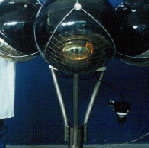
Photo: Camille Moirenc
 |
A small submarine is needed to connect each string of detectors to the 40-kilometer electrical cable, so the signals can be brought from the detectors to the shore. Manned craft like the Nautile are often unavailable—the connection of one prototype string of detectors was delayed for three months while the Nautile worked on the wreck of an oil tanker off the Spanish coast—so researchers are negotiating for the use of unmanned, remotely-operated submarines.
Cosmic fishing expedition
Fourteen hundred kilometers away, another group of researchers prepares to install the Neutrino Extended Submarine Telescope with Oceanographic Research 4000 meters deep in the Mediterranean Sea, 14 kilometers off the coast of Pylos, Greece.
| Deepest Sperm Whale Depth: 1150 meters  NESTOR (When completed) Depth: 4000 meters Tiers: 12 Detectors: 144 |
NESTOR's optical modules sit in groups of two at the ends of giant six-armed titanium stars. The 410-meter high NESTOR detector is a tower made up of a stack of twelve of these 32-meter diameter stars. The tower's depth considerably reduces the background from biolu-minescence, and all electrical connections are made above the surface, eliminating the need for a submarine.
"We follow the standard Mediterranean fishing technique," says physicist Leonidas Resvanis, director of the nestor Institute. "You put your fishing nets on the sea floor, and you have a rope that goes up to a buoy, and you grab the buoy and bring everything up."
One floor of NESTOR has been installed. To install subsequent floors, the entire array will be removed from the sea, the next floor attached, and the whole telescope replaced.
"This is a fishing expedition for cosmic neutrinos. Nobody really knows how big a net you need to catch them."
 |
When completed, ANTARES and NESTOR will be the largest neutrino telescopes in the northern hemisphere, and the largest underwater telescopes. Following hard on their heels, however, is IceCube, a US$270 million neutrino telescope being built under the South Pole. IceCube, AMANDA's successor, will be about 100 times bigger than ANTARES and NESTOR. Similar to AMANDA in design, IceCube will cover one cubic kilometer, 1.5 kilometers below the surface, with 80 strings of 60 optical modules each, for a total of 4800 PMTs. The first few strings of IceCube will be installed this winter, with work continuing on detector deployment every year through 2010.
So when will the first neutrinos from a black hole at the center of a far-off galaxy be spotted in these new telescopes? Scientists aren't sure, but they're hoping that the next ten years will bring big advances.
 Photos: E.G. Anassontzis/NESTOR |
"In astronomy, every time a new type of instrument was made, completely new sources were discovered," says Beacom. "Your stockbroker will say that past performance is no guarantee of future results, but we have every expectation that the neutrino will be extremely important to the future of astronomy and astrophysics."
AMANDA and Baikal continue their searches. NESTOR and ANTARES will be completed by 2007, and IceCube a few years later. Two kilometer-cubed detector arrays for the Mediterranean have been proposed—the Neutrino Mediterranean Observatory near Sicily, and a joint effort by the ANTARES and NESTOR collaborations. "This is a fishing expedition for cosmic neutrinos," says Resvanis. "Nobody really knows how big a net you need to catch them."
Funding sources
The US National Science Foundation is the primary source of funding for IceCube. Construction of IceCube, which NSF lists as a Major Research Equipment project, will cost about US$270 million. The NSF requested $33.4 million in MRE and Facilities Construction funding for IceCube for fiscal year 2005. The administration requested the same amount, and in July the House Appropriations Commit-tee recommended to Congress $51.2 million in funding for IceCube for FY05. This increase of $17.8 million over the request was recommended in the hopes of reducing the overall total project cost. The next step in the FY05 funding process is for the Senate to take action on the VA/HUD spending bill that includes funding for the National Science Foundation. IceCube receives additional funding from the Department of Energy's Office of Science, the University of Wisconsin, and government and private funding agencies in Belgium, Germany, Sweden, and Japan.
The ANTARES neutrino telescope will cost about $25 million to build. Several French governmental agencies and local governments; the European Union; and agencies and institutions in Germany, Italy, Netherlands, Russia, Spain, and the United Kingdom are providing funding for the telescope. nestor, which will cost around $20 million, receives major funding from governmental agencies and institutions in Greece, and additional funding from collaborating institutions in Germany, Russia, Switzerland, and the United States.
Click here to download the pdf version of this article.






